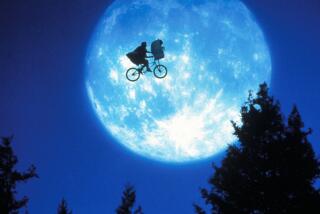Nothing ‘Giant’ Happens
- Share via
More than 40 years later, they’re still talking about the time that “Giant” came to town. It was the biggest thing that ever happened to Marfa, Texas. Judging from the documentary “Return to ‘Giant,’ ” airing Wednesday at 9 on KOCE-TV Channel 50, it still is.
“Giant,” released in 1956, was filmed on location in Marfa by director George Stevens. It starred Rock Hudson, Elizabeth Taylor and James Dean, with a supporting cast of Dennis Hopper and Carroll Baker, who were just emerging, as well as Sal Mineo.
Although the desolate reaches of the Texas Panhandle seem as far from the glitter of celebrity as the steppes of Russia, distance from the famous provides no immunity to being overawed. Distance may even make people more susceptible.
Consequently, it’s understandable why the star-struck denizens of the dusty cattle town got so excited when Stevens and his Hollywood minions arrived in summer 1955.
Less understandable is why anybody but Marfa residents, their relatives and the town’s Chamber of Commerce would be interested in seeing or showing this documentary.
Narrated by Eagles singer Don Henley, “Return to ‘Giant’ ” consists mainly of Marfans recalling how lucky they were to make the (slight) acquaintance of Rock, Liz, Jimmy and the rest, and how inspiring it was to see that stars of dazzling magnitude were like--well, shucks--just plain folks.
In 60 tepid minutes, this documentary reveals almost nothing about the making of “Giant.” It has no outtakes from the picture, no interviews with Stevens, Taylor or Dean, who died in a car crash after he’d finished his work on location two weeks before filming ended.
*
What little “Return to ‘Giant’ ” has to say about “Giant” is invariably dull, sometimes contradictory.
We hear that “Giant” became known lovingly as “the national movie of Texas.” More interesting perhaps is that it painted “an unflattering portrait of the state.” But the chasm between fond anthem and unflattering portrait goes unexplained.
The documentary does have a few short, not very probing clips from a 1982 interview with Hudson, already apparently suffering effects of AIDS; lengthier but still pro forma comments from Baker; unenlightening remarks by a very young-looking Hopper and reminiscences from lesser-known actors in the cast.
In all, Stevens gets the expected praise. But a great irony goes unnoticed. Although Stevens won the Oscar for best director, “Giant” did not get the Oscar for best picture (“Around the World in 80 Days” did), and nobody in the cast won an Oscar, either; ditto for the technical artists. Which makes you wonder why Stevens got his award, especially when you take a look at “Giant” again.
*
The picture just doesn’t hold up. It’s bloated and slow, the acting pure bunk top to bottom. The rags-to-riches drama of Dean as a lovelorn oil baron is stilted; the noble heritage of Hudson as a traditional cattle baron is not credible; the soapbox display of Taylor as feminist spouse is laughable, Stevens’ liberal ideology about Texan racism toward Mexican Americans heavy-handed.
What “Return to ‘Giant’ ” lacks most, apart from sharp interviewing skills or fascinating footage, is context. Feeble attempts by George Stevens Jr., several “expert” observers and, in one instance, the son of a former crew member, fail to explain why “Giant” was so outsize and so typical of its time.
The basic reason, of course, was that Hollywood was trying to distinguish its feature pictures from television, which had come along a few years earlier and was beginning to devour the entertainment competition.
The other best-picture Oscar nominees for 1956 were “The Ten Commandments,” “The King and I” and “Friendly Persuasion.” Diverse though they were, they were all big, long, Technicolor extravaganzas.
The studios hoped to reclaim the millions of moviegoers who were staying home to watch television for free. Huge productions filled with things you couldn’t get on the black-and-white tube--such as 40-foot-high close-ups of glamorous stars or vast panoramas and miraculous special effects--were supposed to do the trick.
But “Return to ‘Giant’ ” couldn’t care less about any of that, it seems, not because the specific place of “Giant” in the social history of both Hollywood and Texas is so well known, but rather because the makers of this documentary are so benighted.
* “Return to ‘Giant’ ” airs Wednesday at 9 p.m. on KOCE-TV Channel 50.
More to Read
The complete guide to home viewing
Get Screen Gab for everything about the TV shows and streaming movies everyone’s talking about.
You may occasionally receive promotional content from the Los Angeles Times.






